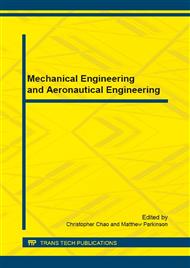[1]
W. Elber, Fatigue crack closure under cyclic tension, Eng. Fract. Mech. 2 (1970) 37–45.
Google Scholar
[2]
S. Cheung, A.R. Luxmoore, A finite element analysis of stable crack growth in an aluminum alloy, Eng. Fract. Mech. 70 (2003) 1153–1169.
DOI: 10.1016/s0013-7944(02)00093-0
Google Scholar
[3]
T. Belytschko, L. Gu, Y.Y. Lu, Fracture and crack growth by element-free Galerkin methods, Mod. Simu. Mat. Sci. Eng. 2 (1994), 519–534.
DOI: 10.1088/0965-0393/2/3a/007
Google Scholar
[4]
S. Kumar, I. V Singh, B. K. Mishra, A Coupled Finite Element and Element-Free Galerkin Approach for the Simulation of Stable Crack Growth in Ductile Materials, Theo. Appl. Fract. Mech. 70 (2014) 49–58.
DOI: 10.1016/j.tafmec.2014.02.006
Google Scholar
[5]
T. Belytschko, T. Black, Elastic crack growth in finite elements with minimal remeshing, Int. J. Numer. Meth. Eng. 45 (1999) 601–620.
DOI: 10.1002/(sici)1097-0207(19990620)45:5<601::aid-nme598>3.0.co;2-s
Google Scholar
[6]
S. Kumar, I. V Singh, B.K. Mishra, T. Rabczuk, Modeling and Simulation of Kinked Cracks by Virtual Node XFEM, Comp. Meth. Appl. Mech. Eng. 283 (2015) 1425–1466.
DOI: 10.1016/j.cma.2014.10.019
Google Scholar
[7]
S. Kumar, I. V Singh, B.K. Mishra, XFEM Simulation of Stable Crack Growth using J-R Curve under Finite Strain Plasticity, Int. J. Mech. Mater. Des. 10 (2014) 165–177.
DOI: 10.1007/s10999-014-9238-1
Google Scholar
[8]
S. Kumar, I.V. Singh, B.K. Mishra, A multigrid coupled (FE-EFG) approach to simulate fatigue crack growth in heterogeneous materials, Theo. Appl. Fract. Mech. 72 (2014) 121–135.
DOI: 10.1016/j.tafmec.2014.03.005
Google Scholar
[9]
S. Kumar, A.S. Shedbale, I.V. Singh, B.K. Mishra, Elasto-plastic fatigue cerack growth analysis of plane problems in the presence of flaws using XFEM, Front. Struct. Civil Eng. (Accepted) (2015b).
DOI: 10.1007/s11709-015-0305-y
Google Scholar
[10]
F. Jiang, K. Zhao, J. Sun, Evaluation of interfacial crack growth in bimaterial metallic joints loaded by symmetric three-point bending, Int. J. Press. Vess. Pip. 80 (2003) 129–137.
DOI: 10.1016/s0308-0161(03)00004-8
Google Scholar


